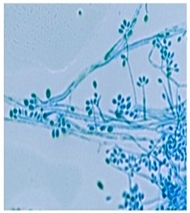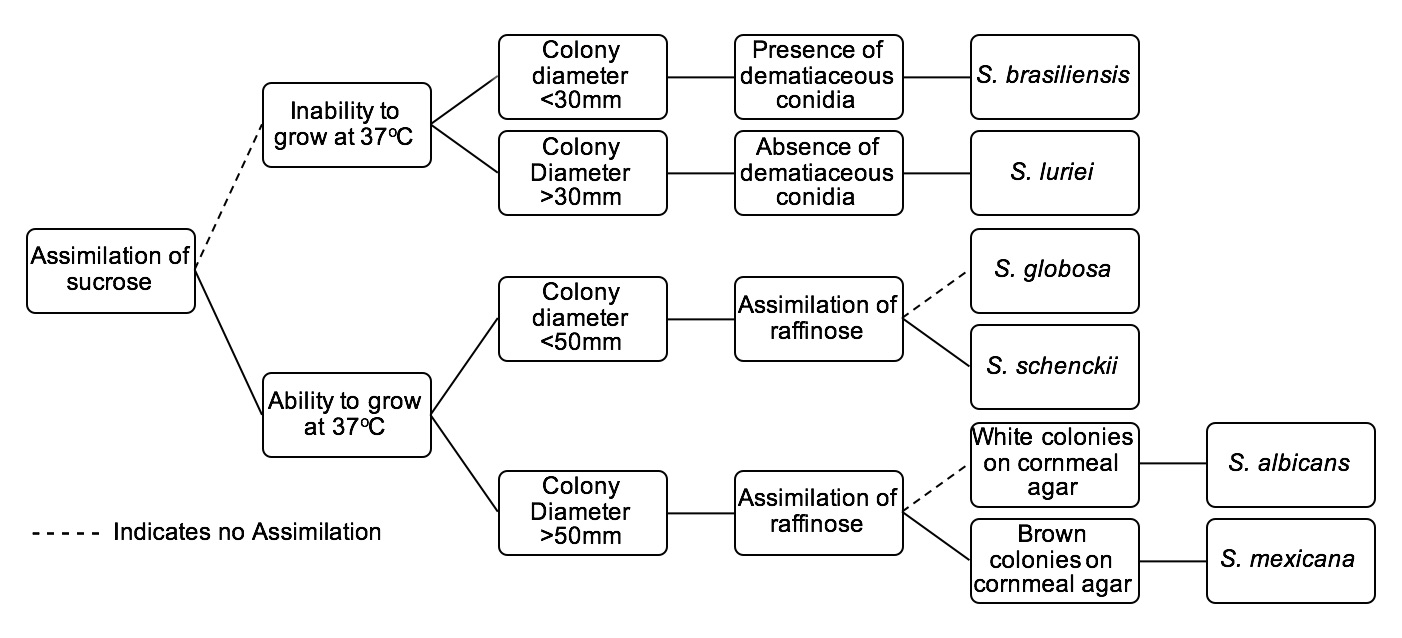Sporothrix schenckii: Difference between revisions
(→Yeast) |
No edit summary |
||
| Line 60: | Line 60: | ||
The specific immune response is active later in infection and involves both [[B cell]]s and [[T cell]]s. Severe sporotrichosis is rare in endemic areas where humans are in near constant contact with ''S. schenckii'' spores. This fact, combined with the increased severity of disease in immunocompromised patients points to an important role for [[adaptive immune system|specific immunity]] in ''S. schenckii'' infection.<ref name="Carlos" /> Patients with sporotrichosis have been shown to produce antibodies specific to ''S. schenckii''<ref name="Scott">{{cite journal |author=Scott EN, Muchmore HG |title=Immunoblot analysis of antibody responses to ''Sporothrix schenckii'' |journal=J. Clin. Microbiol. |volume=27 |issue=2 |pages=300–4 |date=February 1989 |pmc=267296 |pmid=2915023}}</ref> and these antibodies may actually be protective against the disease.<ref name="Barros" /> | The specific immune response is active later in infection and involves both [[B cell]]s and [[T cell]]s. Severe sporotrichosis is rare in endemic areas where humans are in near constant contact with ''S. schenckii'' spores. This fact, combined with the increased severity of disease in immunocompromised patients points to an important role for [[adaptive immune system|specific immunity]] in ''S. schenckii'' infection.<ref name="Carlos" /> Patients with sporotrichosis have been shown to produce antibodies specific to ''S. schenckii''<ref name="Scott">{{cite journal |author=Scott EN, Muchmore HG |title=Immunoblot analysis of antibody responses to ''Sporothrix schenckii'' |journal=J. Clin. Microbiol. |volume=27 |issue=2 |pages=300–4 |date=February 1989 |pmc=267296 |pmid=2915023}}</ref> and these antibodies may actually be protective against the disease.<ref name="Barros" /> | ||
===Culture and Identification=== | |||
[[Image:Sporotree.jpg|thumb|none|800px|From the Thames]] | |||
==References== | ==References== | ||
{{reflist|colwidth=35em}} | {{reflist|colwidth=35em}} | ||
Revision as of 14:17, 22 January 2016
|
Sporotrichosis Microchapters |
|
Diagnosis |
|---|
|
Treatment |
|
Case Studies |
|
Sporothrix schenckii On the Web |
|
American Roentgen Ray Society Images of Sporothrix schenckii |
| style="background:#Template:Taxobox colour;"|Template:Taxobox name | ||||||||||||||
|---|---|---|---|---|---|---|---|---|---|---|---|---|---|---|
 A micrograph of Sporothrix schenckii conidia stained with lactophenol cotton blue
| ||||||||||||||
| style="background:#Template:Taxobox colour;" | Scientific classification | ||||||||||||||
| ||||||||||||||
| Binomial name | ||||||||||||||
| Sporothrix schenckii Hektoen & C.F.Perkins (1900) |
Editor-In-Chief: C. Michael Gibson, M.S., M.D. [2] Alison Leibowitz [3]
Overview
Sporothrix schenckii is a fungus that can be found throughout the world. Areas characterized by warm, humid climates, are ideal for the fungus to thrive. The species is present in soil as well as in and on living and decomposing plant material such as peat moss. It can infect humans as well as animals and is the causative agent of sporotrichosis, commonly known as "rose handler's disease".[1] Posttraumatic inoculation of S. schenckii is the typical method of infection. However, sporotrichosis may also develop as a result of spore inhalation, although this mode of transmission is infrequent. Infection commonly occurs in otherwise healthy individuals but is rarely life-threatening and can be treated with antifungals. In the environment, Sporothrix schenckii exists as a filamentous hyphae. In host tissue, S. schenckii thrives as a yeast. The transition from its hyphal form to yeast form is temperature dependent, making S. schenckii a thermally dimorphic fungus.[2]
Morphology
Sporothrix schenckii can be found in one of two morphologies, mold or yeast, making it a dimorphic fungus. The saprophytic form is found in the environment on plants and decaying matter. When the fungus infects a host, the yeast form predominates as a result of its temperature dependent morphology.[3]
Saprophytic/Hyphal Form
- At 25 °C (77 °F), in the environment or grown in the laboratory (in malt extract agar or potato dextrose agar), S. schenckii assumes its saprophytic stage.[4]
- Macroscopically, colonies are characterized by apparent filaments, a smooth to leathery texture, and a finely wrinkled surface. Initially appearing off-white to creamy, the color may later become dark brown to black (“dirty candle-wax” color).[2] Some strains are capable of growing darkly colored colonies from initial formation.
- Microscopically, composed of hyaline, hyphae are septate and approximately 1 to 2μm in diameter. Arising from undifferentiated hyphae, conidiogenous cells form clusters of conidia on denticles. Conidia, which do not generate chains, are tear to clavate shaped and glass-like in appearance. They may be colorless or darkly colored. Conidia are sometimes referred to as resembling a flower.[5]
Yeast
- At 37 °C (98.6 °F) either in a laboratory or in host tissue, S. schenckii assumes its yeast form.
- Macroscopically, the yeast form grows as smooth, white to tan colonies.
- Microscopically, yeast cells are 2 to 6μm in diameter and have a round to oval shape. Typically, the cells appear to have elongated cigar-shaped buds stemming from a narrow origin.[2] [3]
Virulence Factors
Melanin Production
S. schenckii synthesizes melanin both in vitro and in vivo[4] Melanin production is a virulence factor found in many fungi that cause disease[6] and its production in S. schenckii protects the fungus from oxidative stress as well as ultraviolet light and macrophage killing. Melanin has been shown to be synthesized using the 1,8-DHN pentaketide pathway (below).[4]
Adhesins
Adhesion is an important component of pathogenesis. The yeast form of S. schenckii shows an increased ability to bind[2] to the host extracellular matrix proteins fibronectin and laminin using two separate receptors specific for these proteins.[7]
Proteases
S. schenckii breaks down proteins by producing two separate proteases, a serine protease and an aspartic protease.[8] These proteases appear to be essential for fungal growth. However, they have some functional overlap as the inactivation of either protein does not affect growth but inactivation of both inhibits the fungus.[9] Protease activity has been shown to be important in in vivo infection of mice.[8] Substrates for these proteases include the skin proteins type-I collagen, stratum corneum, and elastin.[8]
Heat Tolerance
Growing at host body temperature (37 °C (98.6 °F)) is an important requirement for pathogenesis. Some strains of S. schenckii are restricted to growing at 35 °C (95 °F) and consequently usually cause disease only on the skin as it is cooler than the body's interior. Those that are capable of growth at body temperature are more often associated with disseminated disease.[8]
Immune Response
Infection by S. schenckii is generally self-limiting in immunocompetent hosts. The immune response prevents fungal dissemination and is the reason that most Sporothrix infections are cutaneous.[10]
Innate
The yeast form of S. schenckii is effectively phagocytosed by cells of the innate immune system[10] and are recognized based on the sugars displayed on their surface[11] or lipids in the yeast cell mebrane.[10] Although they are taken up, they are not efficiently killed. It is hypothesized that ergosterol peroxide reacts with and detoxifies reactive oxygen species generated by the respiratory burst used by phagocytes to kill cells they have ingested.[10] S. schenckii is also capable of modulating the immune response to promote its own survival by blocking cytokine production by macrophages.[10]
Specific
The specific immune response is active later in infection and involves both B cells and T cells. Severe sporotrichosis is rare in endemic areas where humans are in near constant contact with S. schenckii spores. This fact, combined with the increased severity of disease in immunocompromised patients points to an important role for specific immunity in S. schenckii infection.[10] Patients with sporotrichosis have been shown to produce antibodies specific to S. schenckii[12] and these antibodies may actually be protective against the disease.[2]
Culture and Identification

References
- ↑ Vásquez-del-Mercado E, Arenas R, Padilla-Desgarenes C (July 2012). "Sporotrichosis". Clin. Dermatol. 30 (4): 437–43. doi:10.1016/j.clindermatol.2011.09.017. PMID 22682194.
- ↑ 2.0 2.1 2.2 2.3 2.4 Barros MB, de Almeida Paes R, Schubach AO (October 2011). "Sporothrix schenckii and Sporotrichosis". Clin. Microbiol. Rev. 24 (4): 633–54. doi:10.1128/cmr.00007-11. PMC 3194828. PMID 21976602.
- ↑ 3.0 3.1 Barros MB, de Almeida Paes R, Schubach AO (2011). "Sporothrix schenckii and Sporotrichosis". Clin Microbiol Rev. 24 (4): 633–54. doi:10.1128/CMR.00007-11. PMC 3194828. PMID 21976602.
- ↑ 4.0 4.1 4.2 Morris-Jones R, Youngchim S, Gomez BL; et al. (July 2003). "Synthesis of melanin-like pigments by Sporothrix schenckii in vitro and during mammalian infection". Infect. Immun. 71 (7): 4026–33. doi:10.1128/iai.71.7.4026-4033.2003. PMC 161969. PMID 12819091.
- ↑ [1] Mycology Online - University of Adelaide
- ↑ Revankar SG, Sutton DA (October 2010). "Melanized fungi in human disease". Clin. Microbiol. Rev. 23 (4): 884–928. doi:10.1128/cmr.00019-10. PMC 2952981. PMID 20930077.
- ↑ Lima OC, Bouchara JP, Renier G, Marot-Leblond A, Chabasse D, Lopes-Bezerra LM (September 2004). "Immunofluorescence and flow cytometry analysis of fibronectin and laminin binding to Sporothrix schenckii yeast cells and conidia". Microb. Pathog. 37 (3): 131–40. doi:10.1016/j.micpath.2004.06.005. PMID 15351036.
- ↑ 8.0 8.1 8.2 8.3 Hogan LH, Klein BS, Levitz SM (October 1996). "Virulence factors of medically important fungi". Clin. Microbiol. Rev. 9 (4): 469–88. PMC 172905. PMID 8894347.
- ↑ Tsuboi R, Sanada T, Ogawa H (July 1988). "Influence of culture medium pH and proteinase inhibitors on extracellular proteinase activity and cell growth of Sporothrix schenckii". J. Clin. Microbiol. 26 (7): 1431–3. PMC 266631. PMID 3045155.
- ↑ 10.0 10.1 10.2 10.3 10.4 10.5 Carlos IZ, Sassá MF, da Graça Sgarbi DB, Placeres MC, Maia DC (July 2009). "Current research on the immune response to experimental sporotrichosis". Mycopathologia. 168 (1): 1–10. doi:10.1007/s11046-009-9190-z. PMID 19241140.
- ↑ Oda LM, Kubelka CF, Alviano CS, Travassos LR (February 1983). "Ingestion of yeast forms of Sporothrix schenckii by mouse peritoneal macrophages". Infect. Immun. 39 (2): 497–504. PMC 347978. PMID 6832808.
- ↑ Scott EN, Muchmore HG (February 1989). "Immunoblot analysis of antibody responses to Sporothrix schenckii". J. Clin. Microbiol. 27 (2): 300–4. PMC 267296. PMID 2915023.